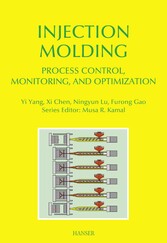Yi Yang, Xi Chen, Ningyun Lu, Furong Gao
Injection Molding Process Control, Monitoring, and Optimization
Chapter 1 INJECTION MOLDING: MACHINE AND PROCESS
1.1Introduction of general polymer processing
1.2Polymer material and characteristics
1.3Injection molding machine
1.4Injection molding process
Chapter 2 EVOLUTION OF SYSTEMS TECHNOLOGIES IN INJECTION MOLDING
2.1 Introduction of systems technology
2.2 Evolution of process control technology in injection molding
2.3 Evolution of process monitoring technology in injection molding
2.4 Evolution of process optimization technology in injection molding
Control
Chapter 3 FEEDBACK CONTROL ALGORITHMS DEVELOPED FOR CONTINUOUS PROCESSES
3.1 Introduction of feedback control background
3.2 Traditional feedback control: PID
3.3 Adaptive control
3.4 Model predictive control: GPC
3.5 Optimal control
3.6 Fuzzy and Artificial Neural Networks control
Chapter 4 LEARNING TYPE CONTROL DEVELOPED FOR REPETITIVE PROCESS
4.1 Introduction of learning type control background
4.2 Basic iterative learning control
4.3 Optimal iterative learning control
Chapter 5 TWO-DIMENSIONAL CONTROL ALGORITHMS
5.1 Introduction of two-dimensional control background
5.2 Two-dimensional robust control
5.3 Two-dimensional optimal control
5.4 Two-dimensional model predictive control
Chapter 6 FAULT-TOLERANT CONTROL IN INJECTION MOLDING
6.1 Introduction of fault-tolerant control injection molding
6.2 Active fault-tolerant control with sensor failure: an example
Monitoring
Chapter 7 STATISTICAL PROCESS MONITORING (SPM)
7.1 Process monitoring for continuous processes
7.2 Process monitoring for batch processes
Chapter 8 SPM BASED ON PHASE RECOGNITION AND HARD PARTITION STRATEGY
8.1 Data-driven phase recognition and phase partition
8.2 Phase-based SPM in injection molding
8.3 SPM with limited modeling data
8.4 Quality-oriented process monitoring
Chapter 9 SPM BASED ON SOFT PHASE PARTITION STRATEGY
9.1 Transition-based soft phase partition
9.2 Soft phase-based SPM in injection molding
9.3 Dissimilarity analysis based process monitoring
9.4 Dissimilarity analysis based nonlinear process monitoring
9.5 Adaptive process monitoring in injection molding
Chapter 10 TWO-DIMENSIONAL MODEL-BASED PROCESS MONITORING & FAULT DIAGNOSIS
10.1 Two dimensional dynamic principal component analysis (2D-DPCA)
10.2 2D-DPCA based process monitoring
10.3 2D-DPCA based fault diagnosis
Optimization
Chapter 11 IN-MOLD CAPACITIVE TRANSDUCER FOR INJECTION MOLDING PROCESS
11.1Principle of capacitive transducers
11.2Hardware design of the in-mold capacitive transducer
11.3Detection of the melt flow in filling stage
11.4Detection of in-mold status in packing & cooling stage
11.5Application for online part weight prediction and fault detection
Chapter 12 OPTIMAL PROFILING FOR FILLING STAGE
12.1Introduction
12.2Constant melt-front-velocity strategy
12.3Soft-sensor development of average-flow-length
12.4Uniform filling based on optimization
12.5Optimal profile of injection velocity for different mold shapes
Chapter 13 OPTIMAL PROFILING FOR PACKING STAGE
13.1Introduction
13.2Online auto-detection of gate freezing-off point
13.3Influence of packing profile on part quality
13.4Profiling of packing pressure
Chapter 14 PARAMETER SETTING FOR PLASTICATION STAGE
14.1Introduction
14.2Neural network modeling of melt temperature
14.3Optimal parameter setting
Chapter 15 MODEL FREE OPTIMIZATION FOR PART QUALITY CONTROL
15.1Model free optimization strategy for injection molding process
15.2Gradient-based algorithm
15.3Non-gradient-based algorithm
15.4Part weight control via MFO
15.5Focal length control via MFO
© 2009-2024 ciando GmbH
 Zu Hanser-Fachbuch.de
Zu Hanser-Fachbuch.de
 Warenkorb
Warenkorb
